-
LCO-301
LACTATE OXIDASE from Microorganism

PREPARATION and SPECIFICATION
| Appearance | Yellowish amorphous powder, lyophilized | |
|---|---|---|
| Activity | GradeⅢ 80U/mg-solid or more | |
| Contaminants | Pyruvate oxidase | ≤1.0×10-3% |
| Cholesterol oxidase | ≤1.0×10-3% | |
| Uricase | ≤1.0×10-3% | |
| Glucose oxidase | ≤1.0×10-3% | |
PROPERTIES
| Stability | Stable at −20℃ for at least one year(Fig.1) |
|---|---|
| Molecular weight | approx. 160,000 (by gel filtration) |
| Isoelectric point | 4.3±0.2 |
| Michaelis constant | 1.0×10-3M (L-Lactate) |
| Inhibitors | Fe+++, SDS |
| Optimum pH | 7.5(Fig.2) |
| Optimum temperature | 35−40℃(Fig.3) |
| pH Stability | 4.0−9.8 (25℃, 16hr)(Fig.4) |
| Thermal stability | below 50℃ (pH 7.0, 10min)(Fig.5) |
| Effect of various chemicals | (Table 1) |
APPLICATIONS
This enzyme is useful for enzymatic determination of L-lactate
ASSAY
Principle


The appearance of quinoneimine dye is measured at 555nm by spectrophotometry.
Unit definition
One unit causes the formation of one micromole of hydrogen peroxide (half a micromole of quinoneimine dye) per minute under the conditions described below.
Method
Reagents
| A. DL-Lactate solution | 0.125M [240mg of DL-lithium lactate (MW=96.01)/20ml of 50mM K-PB pH7.5] (Should be prepared fresh) | |
|---|---|---|
| B. 4-AA solution | 0.5% (500mg of 4-aminoantipyrine/100ml of H2O) (Store at 4℃ in a brownish bottle) | |
| C. EHSPT(TOOS) solution | 20mM [591mg N-ethyl-N-(2-hydroxy-3-sulfopropyl)-m-toluidine (MW=295.3)/100ml of H2O] (Store at 4℃ in a brownish bottle) | |
| D. Peroxidase solution | 25U/ml [ca. 23mg of horseradish peroxidase (Toyobo GradeⅢ, 110 purpurogallin units/mg)/100 ml of H2O] | |
| E. SDS solution | 0.25% (500mg sodium dodecyl sulfate/200ml of H2O) | |
| F. Enzyme diluent | 20mM K-PB, pH7.0 containing 0.1%(w/v) sodium cholate | |
Procedure
1. Prepare the following working solution (20 tests) in a brownish bottle, and store on ice.
| 8.0ml | DL-Lactate solution | (A) |
| 1.2ml | 4-AA solution | (B) |
| 0.8ml | EHSPT solution | (C) |
| 2.0ml | Peroxidase solution | (D) |
| 8.0ml | distilled water |
| Concentration in assay mixture | |
|---|---|
| K-phosphate buffer | 20 mM |
| DL-Lactate | 48 mM |
| 4-Aminoantipyrine | 1.2 mM |
| EHSPT | 0.76 mM |
| Peroxidase | 2.4 U/ml |
2. Pipette 1.0ml of working solution into a test tube and equilibrate at 37℃ for about 5 minutes.
3. Add 0.05ml of the enzyme solution* and mix.
4. After exactly 15minutes at 37℃, add 2.0ml of SDS solution (E) to stop the reaction and measure the optical density at 555nm against water (ODtest).
At the same time, prepare the blank by using the same method as the test except that the enzyme diluent (F) is used instead of the enzyme solution (ODblank).
*Dissolve the enzyme preparation in ice-cold 20mM ACES-NaOH pH7.0 containing 1mM EDTA and 0.5%(w/v) sodium cholate, and dilute to 0.04−0.1 U/ml with the enzyme diluent (F) immediately before assay.
Calculation
Activity can be calculated by using the following formula :
Volume activity (U/ml) =
-
ΔOD (OD test−OD blank)×Vt×df
34.3×1/2×t×1.0×Vs
= ΔOD×0.237×df
Weight activity (U/mg) = (U/ml)×1/C
| Vt | : Total volume (3.05ml) |
| Vs | : Sample volume (0.05ml) |
| 34.3 | : Millimolar extinction coefficient of quinoneimine dye under the assay condition (㎠/micromole) |
| 1/2 | : Factor based on the fact that one mole of H2O2 produced half a mole of quinoneimine dye |
| t | : Reaction time (15minutes) |
| 1.0 | : Light path length (cm) |
| C | : Enzyme concentration in dissolution (C mg/ml) |
REFERENCES
1) A. Toda, and Y. Nishiya; J. Ferment. Technol., 85, 507 (1998)
Table 1. Effect of Various Chemicals on Lactate oxidase
[The enzyme solution dissolved in 20mM ACES-NaOH, pH7.0 (50U/ml) was incubated with each chemical at 25℃ for 1hr.]
-
Chemical Concn.(mM) Residual
activity(%)None - 100 Metal salt 2.0 MgCl2 100 CaCl2 101 Ba(OAc)2 101 FeCl3 5 CoCl2 100 MnCl2 100 ZnCl2 94 Cd(OAc)2 91 NiCl2 99 CuSO4 94 AgNO3 54 MIA 2.0 94 NEM 2.0 99 -
Chemical Concn.(mM) Residual
activity(%)IAA 2.0 90 Hydroxylamine 2.0 99 EDTA 5.0 94 o-Phenanthroline 2.0 100 α,α′-Dipyridyl 2.0 94 Borate 50.0 97 NaF 2.0 99 NaN3 2.0 100 Triton X-100 0.10% 98 Brij 35 0.10% 86 Tween 20 0.10% 81 Span 20 0.10% 96 Na-cholate 0.10% 101 DAC 0.05% 76 SDS 0.05% 0
Ac, CH3CO; MIA, Monoiodoacetate; NEM, N-ethylmaleimide; IAA, Iodoacetate; EDTA, Ethylenediaminetetraacetate; SDS, Sodium dodecyl sulfate; DAC, Dimethylbenzylalkylammonium chloride.
-
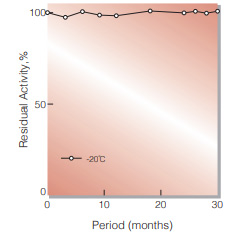
Fig.1. Stability (Powder form)
(kept under dry conditions)
-
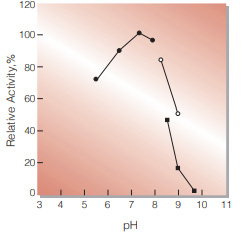
Fig.2. pH-Activity
(37℃, in 20mM buffer solution
●, pH5.7-7.9 K-phosphate;
○, pH8.2-9.0 borate;
■, pH8.6-9.6 glycine-NaOH) -
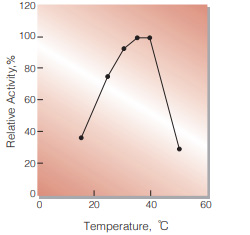
Fig.3. Temperature activity
(in 20mM K-phosphate , pH7.5)
-
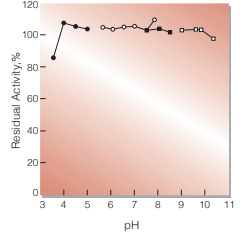
Fig.4. pH-Stability
(25℃, 16hr-treatment with 50mM buffer solution:
●, pH3.6-5.0 acetate;
○, pH5.6-7.8 K-phosphate;
■, pH7.5-8.5 Tris-HCl; □, pH8.9-10.2 glycine-NaOH) -
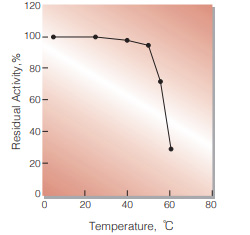
Fig.5. Thermal stability
(10min-treatment with 20mM ACES-NaOH, pH7.0. Enzyme concentration: 100U/ml)
活性測定法(Japanese)
1. 原理


4-AminoantipyrineとEHSPTの酸化縮合物であるQuinoneimine色素を555nmで測定し, 上記反応で生成したH2O2量を定量する。
2.定義
下記条件下で1分間に1マイクロモルのH2O2を生成する酵素量を1単位(U)とする。
3.試薬
- 0.125M DL-乳酸溶液〔240㎎のDL-乳酸リチ ウム(MW=96.01)を50mM K-PB pH7.5に溶解 し, 最終液量を20㎖とする。〕 (用時調製)
- 0.5% 4-AA水溶液 (500㎎の4-アミノアンチピ リンを蒸留水に溶解し, 最終液量を100㎖とす る。) (褐色瓶中で4℃保存)
- 20m M EHSPT(TOOS)水溶液(591mgのEHSPT (MW=295.3)を蒸留水に溶解し, 最終液量を100mlとする。) (褐色瓶中で4℃保存)
- 25U/ml POD水溶液 (約23mgの西洋ワサビ由来ペルオキシダーゼ(東洋紡製,GradeⅢ) (110プルプロガリン単位/mg)を冷蒸留水に溶解し,最終液量を100mlとする。)
- 0.25% SDS水溶液(500mgのドデシル硫酸ナトリウム(SDS)を蒸留水に溶解し, 最終液量を200mlとする。)
酵素溶液:酵素標品を予め氷冷した1.0mM EDTA,0.5%(w/v)コール酸ナトリウムを含む20mMACES-NaOH,pH7.0で溶解し,分析直前に0.1%(w/v)コール酸ナトリウムを含む20mMK-リン酸緩衝液, pH7.0で希釈する。
4.手順
1.下記反応混液(20テスト分)を調製する(褐色瓶にて氷冷保存)
| 8.0ml | DL-乳酸溶液 | (A) |
| 1.2ml | 4-AA水溶液 | (B) |
| 0.8ml | EHSPT水溶液 | (C) |
| 2.0ml | POD水溶液 | (D) |
| 8.0ml | 蒸留水 |
2.反応混液1.0mlを試験管に採り, 37℃で約5分間予備加温する。
3.酵素溶液0.05mlを加え, 反応を開始する。
4.37℃で正確に15分反応させた後, SDS水溶液(E)2.0mlを加えて反応を停止させる。この液につき水を対照に555nmにおける吸光度を測定する(ODtest)。
5.盲検は酵素溶液の代わりに酵素希釈液〔0.1%(w/v)コール酸ナトリウムを含む20mM K-リン酸緩衝液,pH7.0〕を用い, 上記同様に操作を行って吸光度を測定する(ODblank)。
5.計算式
U/ml =
-
ΔOD (OD test−OD blank)×3.05(ml)×希釈倍率
34.3×1/2×15(分)×1.0×0.05(ml)
| = ΔOD×0.237×希釈倍率 | |
| U/mg | = U/ml×1/C |
| 34.3 | : Quinoneimine色素の上記測定条件下でのミリモル分子吸光係数(cm2/micromole) |
| 1/2 | : 酵素反応で生成したH2O2の1分子から形成するQuinoneimine色素は1/2分子であることによる係数 |
| 1.0 | : 光路長(cm) |
| C | : 溶解時の酵素濃度(c mg/ml) |
CONTACT
お問い合わせ-
各種製品に関するご質問・ご相談はこちらよりお問い合わせください。
